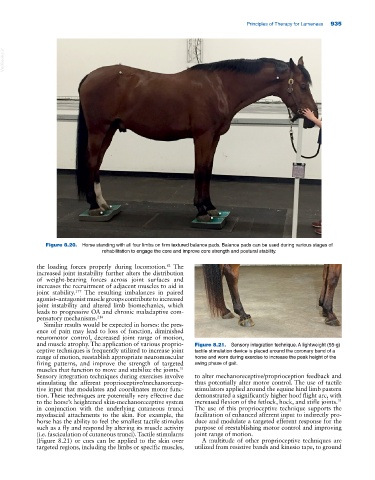Page 969 - Adams and Stashak's Lameness in Horses, 7th Edition
P. 969
Principles of Therapy for Lameness 935
VetBooks.ir
Figure 8.20. Horse standing with all four limbs on firm textured balance pads. Balance pads can be used during various stages of
rehabilitation to engage the core and improve core strength and postural stability.
the loading forces properly during locomotion. The
82
increased joint instability further alters the distribution
of weight‐bearing forces across joint surfaces and
increases the recruitment of adjacent muscles to aid in
joint stability. The resulting imbalances in paired
177
agonist–antagonist muscle groups contribute to increased
joint instability and altered limb biomechanics, which
leads to progressive OA and chronic maladaptive com-
pensatory mechanisms. 214
Similar results would be expected in horses: the pres-
ence of pain may lead to loss of function, diminished
neuromotor control, decreased joint range of motion,
and muscle atrophy. The application of various proprio- Figure 8.21. Sensory integration technique. A lightweight (55‐g)
ceptive techniques is frequently utilized to increase joint tactile stimulation device is placed around the coronary band of a
range of motion, reestablish appropriate neuromuscular horse and worn during exercise to increase the peak height of the
firing patterns, and improve the strength of targeted swing phase of gait.
muscles that function to move and stabilize the joints.
31
Sensory integration techniques during exercises involve to alter mechanoreceptive/proprioception feedback and
stimulating the afferent proprioceptive/mechanorecep- thus potentially alter motor control. The use of tactile
tive input that modulates and coordinates motor func- stimulators applied around the equine hind limb pastern
tion. These techniques are potentially very effective due demonstrated a significantly higher hoof flight arc, with
to the horse’s heightened skin‐mechanoreceptive system increased flexion of the fetlock, hock, and stifle joints.
31
in conjunction with the underlying cutaneous trunci The use of this proprioceptive technique supports the
myofascial attachments to the skin. For example, the facilitation of enhanced afferent input to indirectly pro-
horse has the ability to feel the smallest tactile stimulus duce and modulate a targeted efferent response for the
such as a fly and respond by altering its muscle activity purpose of reestablishing motor control and improving
(i.e. fasciculation of cutaneous trunci). Tactile stimulants joint range of motion.
(Figure 8.21) or cues can be applied to the skin over A multitude of other proprioceptive techniques are
targeted regions, including the limbs or specific muscles, utilized from resistive bands and kinesio tape, to ground

